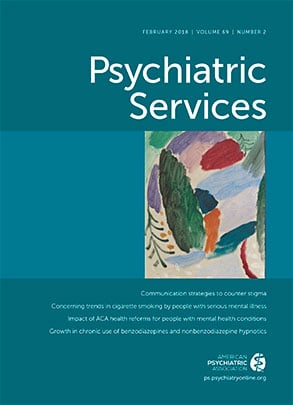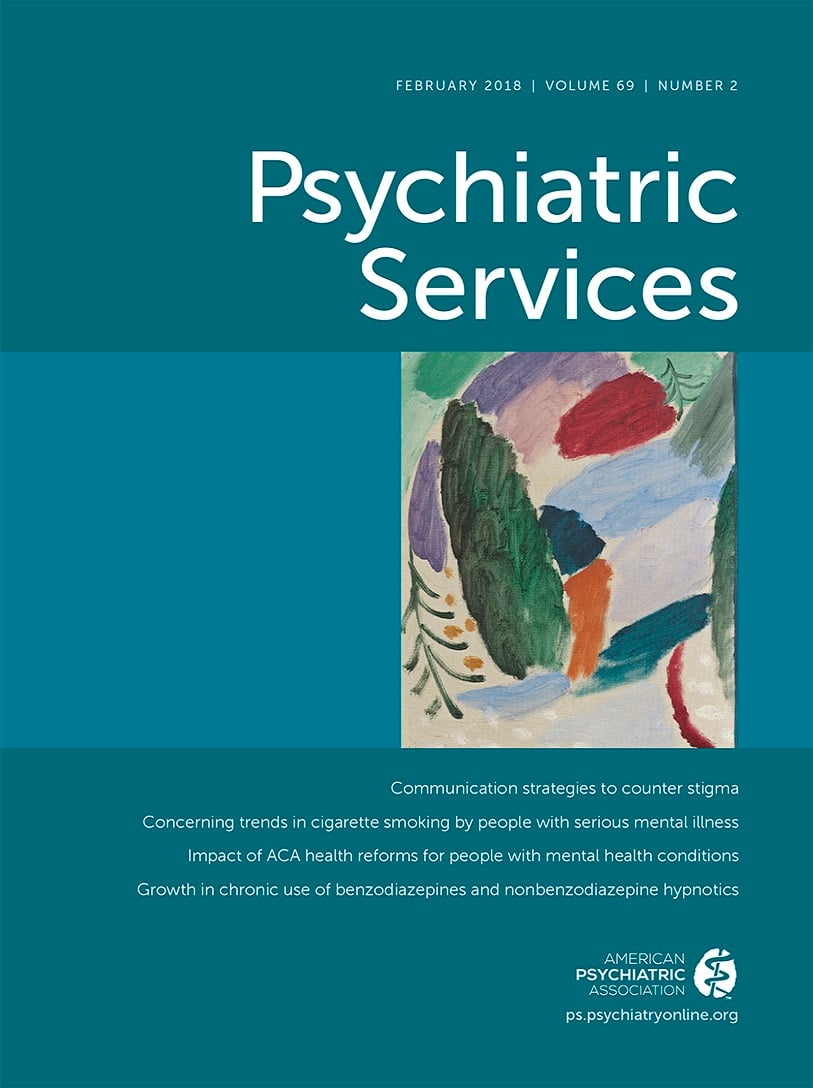Police use of force and injuries may occur at increased rates during interactions between police and people with mental illness (
1), although perception of a mental illness by officers may not predict fatal police shootings (
2). Over the past three decades, the Memphis crisis intervention team (CIT) model (
3–
5), mobile crisis teams, and specialized programs such as Mental Health First Aid (
6) have emphasized de-escalation skills and mental health literacy to increase diversion to psychiatric treatment.
Colorado has broad regional differences in access to mental health care and only 16.9 psychiatric beds per 100,000 population. Police are often the first point of contact for persons during a mental health crisis (
1,
7,
8). In 2002, the Colorado Division of Criminal Justice established a standardized statewide CIT program with the goals of increasing diversion to treatment and reducing unnecessary arrests, injuries, use of force, and Special Weapons and Tactics (SWAT) callouts by increasing officers' knowledge of mental illness, developing verbal crisis de-escalation skills, and improving awareness of local mental health resources. Colorado’s CIT program is regionalized; each region has a steering committee comprising cross-system stakeholders who collaboratively plan and implement their programs geared to local needs and resources. These include implementing Colorado’s standardized 40-hour CIT training curriculum; developing call-taker and dispatcher protocols; establishing procedures for stabilization, observation, and disposition of crisis calls; streamlining transportation and custodial transfer; and providing for program evaluation. Strong partnerships with stakeholder groups such as community mental health centers, local mental health care providers, hospitals, and advocacy organizations have led to the development of outgrowth programs such as postcrisis case management, community re-entry case management in county jails, and specialty problem-solving courts for criminal cases with a mental health nexus. To ensure program fidelity, experienced CIT course directors serve as instructor-trainers for course directors in new regions. Course content is delivered by local mental health professionals and other subject matter experts (
9).
This study tested whether CIT-trained officers would be more likely to transfer a person experiencing a mental illness crisis to jail or to a psychiatric facility for treatment if that person shows violence potential, such as wielding a lethal weapon. The study identified factors associated with the disposition of crisis calls, comparing the likelihood of transfer to treatment, jail, or home versus no transfer required for each factor, and reported prevalence of injuries, SWAT callouts, use of force, and arrests during the first decade (April 2002 to November 2011) of Colorado’s statewide CIT initiative.
Methods
The Office of Research and Statistics of the Division of Criminal Justice developed the CIT Data Collection Form (CIT-DCF), a two-page questionnaire that collects descriptive, demographic, and outcomes data on police responses to mental health crisis calls. The state encouraged but did not require officers to complete the CIT-DCF. Officers completed the CIT-DCF after calls that were classified as a “CIT call” on the basis of the perceived mental state of the subject of the call and the officers’ use of crisis de-escalation skills; completed forms were submitted to the Office of Research and Statistics. The number of CIT-trained officers increased yearly, reaching nearly 7,000 certified officers from 70 law enforcement agencies by 2012.
Items from the CIT-DCF were binary coded (present/absent) after removing officer and participant personal identifiers. Anonymous and aggregate analysis and reporting of data complied with applicable federal, state, and local legal requirements. Statistical analyses used commercial software (Stata, version 12). Relationships of selected factors to outcomes were modeled with multinomial logistic regression. Coefficients are reported as relative risk ratios and their 95% confidence intervals.
Results
A total of 1,167 out of 7,000 (16.7%) CIT-trained officers completed 6,355 CIT-DCF forms on 23.3±26.6 (range 1–128) calls per officer. Over 95% of subjects (N=5,762) of calls were involved in three or fewer incidents during the study years (2002–2011). Data on the total number of mental health–related crisis calls in participating jurisdictions were not available. [Original complaint and disposition of calls and participating law enforcement agencies are reported in an online supplement to this report.]
Because two individuals died by suicide at the scene, only 6,353 incidents could be analyzed for disposition. Age, sex and ethnicity were omitted on some incident reports. Incidents involved men in 3,331 (N=6,326, 52.7%) cases and women in 2,995 (N=6,326, 47.3%). Most (N=4,832 of 6,189, 78.1%) involved adults (age ≥18 years) [see figure in supplement]. Ethnic distribution (N=6,181) was ranked as follows: Caucasian (N=4,951, 80.1%), Hispanic (N=626, 10.1%), African American (N=446, 7.2%), Asian (N=77, 1.25%), mixed race (N=45, 73%), and Native American (N=36, .58%). In most incidents (N=3,964, 62.4%), at least one psychiatric diagnosis was reported. Alcohol or drug abuse was prevalent (N=2,226, 38.6%) [see online supplement].
Among 6,353 crisis calls, most (N=3,623, 57.0%) were for suicide risk, including threats (N=2,536, 39.9%) and attempts (N=1,092, 17.2%). Calls involved threats of violence to others in 16.2% (N=1,027). Force was required in 5.0% (N=317), and SWAT was called out in .82% (N=52) of incidents. Injuries occurred in 824 out of 6,353 (13.0%) incidents, mostly (N=797, 12.6%) prior to police contact. Over 95% (N=6,043) did not result in arrest, and a majority involved transport to a treatment facility (N=3,225, 50.8%; N=2,575, 40.5% with a 72-hour mental health hold).
The relative risk of being transported to a clinical facility (versus no transfer required) was 2.54 for those with a psychiatric diagnosis, 2.18 for those at risk of suicide, 1.78 for those with a weapon, 1.50 for those who reported abuse of drugs or alcohol, and 1.22 for those who presented a threat of violence. The risk of being transported (versus no transfer) to jail was 3.46 for those with a threat of violence, 1.65 for those with reported abuse of drugs or alcohol, 1.41 for those with a weapon, and .69 for those at risk of suicide (
Table 1).
Discussion
This is the first report of systematic assessment of a statewide post-CIT experience. Incidents involving individuals in crisis who had a psychiatric illness, threatened or attempted suicide, abused substances, threatened violence, or had a weapon were more likely to be diverted to treatment, whereas violence threat, presence of a lethal weapon and substance use increased, and suicide threat decreased, the likelihood of transfer to jail. These findings accord with previous, relevant research (
4,
10–
14). This study found that officers’ perceptions of alcohol or drug abuse by the individual was associated with decisions to transfer to either treatment or jail, whereas suicide risk and presence of a psychiatric illness apparently influenced the decision to transfer to clinical treatment, and threat of violence led to transfer to jail. Most of the incidents analyzed involved adults, but a striking 22% (N=1,357) involved juveniles under age 18, including 18 of 29 (62.1%) with a legal disposition that was resolved at a Juvenile Assessment Center. Most crises involving persons over age 60 (5% of the total) were resolved at home or by transfer to a hospital.
Study limitations included lack of comparable pre- or non-CIT data, the absence of data on total number of “mental health calls” from which study incidents were sampled, and the low rate of participation by trained officers (17%), which significantly limited the generalizability of findings. Strengths included fidelity of Colorado’s CIT program to the Memphis model and broad sampling across the entire state over several years.
Conclusions
Despite significant limitations, this study of Colorado’s CIT implementation showed encouraging results for diversion to treatment by trained officers handling mental health–related crisis calls, even in the presence of lethal weapons, and showed promise for the nonviolent resolution of crisis calls.

